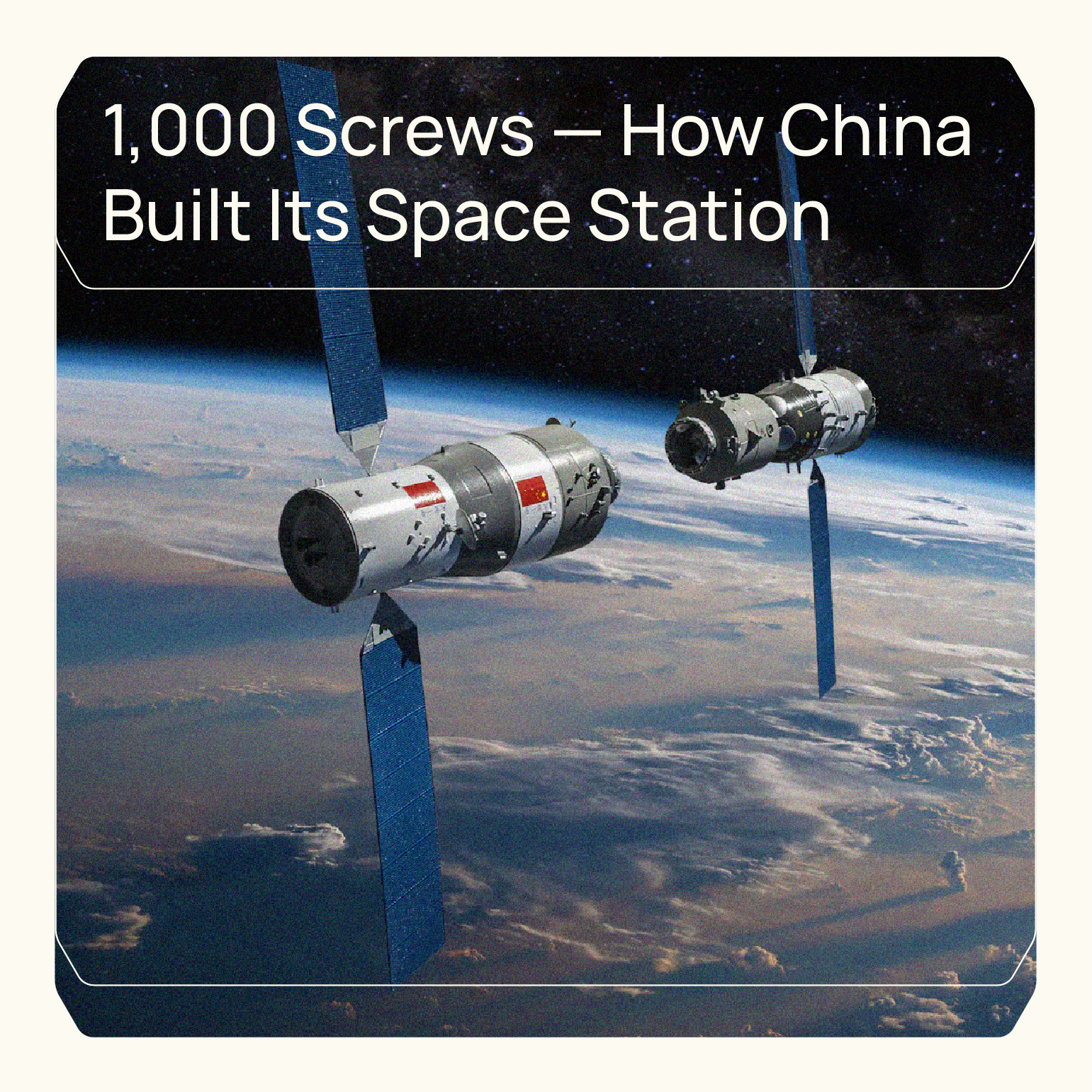
1,000 Screws — How China Built Its Space Station
Tsamouris, the Fastener Specialists©
In the summer of 2021, China's ambitious Tiangong space station project was well underway, with the core module, Tianhe, already in orbit and astronauts busy configuring the station for future crews. The project, which had been in planning since the late 1990s, is a testament to China's growing space capabilities and its commitment to long-term human presence in Earth's orbit.
The construction of the Tiangong space station was a complex undertaking, requiring precision — the astronauts had over 1,000 screws to remove in the core module alone, highlighting the complexity of the assembly process.
Tianhe, which weighs 22.5 tons, was launched on a Long March-5B rocket and served as the foundation for the station. It contained all the necessary life support systems, living quarters, and docking ports for future modules and spacecraft.
The Tiangong space station is just one of many notable achievements by the Chinese space program in recent years, including successful lunar sample-return and Mars rover missions. With the operation of the Mengtian and Wentian laboratory modules, the station serves as a crucial platform for scientific research and a stepping stone for China's future lunar and Martian exploration efforts.
At Tsamouris, we understand the critical role that precision fasteners play in pushing the boundaries of human exploration and scientific discovery.
In the summer of 2021, China's ambitious Tiangong space station project was well underway, with the core module, Tianhe, already in orbit and astronauts busy configuring the station for future crews. The project, which had been in planning since the late 1990s, is a testament to China's growing space capabilities and its commitment to long-term human presence in Earth's orbit.
The construction of the Tiangong space station was a complex undertaking, requiring precision — the astronauts had over 1,000 screws to remove in the core module alone, highlighting the complexity of the assembly process.
Tianhe, which weighs 22.5 tons, was launched on a Long March-5B rocket and served as the foundation for the station. It contained all the necessary life support systems, living quarters, and docking ports for future modules and spacecraft.
The Tiangong space station is just one of many notable achievements by the Chinese space program in recent years, including successful lunar sample-return and Mars rover missions. With the operation of the Mengtian and Wentian laboratory modules, the station serves as a crucial platform for scientific research and a stepping stone for China's future lunar and Martian exploration efforts.
At Tsamouris, we understand the critical role that precision fasteners play in pushing the boundaries of human exploration and scientific discovery.
1,000 Screws — How China Built Its Space Station

Tsamouris, the Fastener Specialists©
In the summer of 2021, China's ambitious Tiangong space station project was well underway, with the core module, Tianhe, already in orbit and astronauts busy configuring the station for future crews. The project, which had been in planning since the late 1990s, is a testament to China's growing space capabilities and its commitment to long-term human presence in Earth's orbit.
The construction of the Tiangong space station was a complex undertaking, requiring precision — the astronauts had over 1,000 screws to remove in the core module alone, highlighting the complexity of the assembly process.
Tianhe, which weighs 22.5 tons, was launched on a Long March-5B rocket and served as the foundation for the station. It contained all the necessary life support systems, living quarters, and docking ports for future modules and spacecraft.
The Tiangong space station is just one of many notable achievements by the Chinese space program in recent years, including successful lunar sample-return and Mars rover missions. With the operation of the Mengtian and Wentian laboratory modules, the station serves as a crucial platform for scientific research and a stepping stone for China's future lunar and Martian exploration efforts.
At Tsamouris, we understand the critical role that precision fasteners play in pushing the boundaries of human exploration and scientific discovery.
In the summer of 2021, China's ambitious Tiangong space station project was well underway, with the core module, Tianhe, already in orbit and astronauts busy configuring the station for future crews. The project, which had been in planning since the late 1990s, is a testament to China's growing space capabilities and its commitment to long-term human presence in Earth's orbit.
The construction of the Tiangong space station was a complex undertaking, requiring precision — the astronauts had over 1,000 screws to remove in the core module alone, highlighting the complexity of the assembly process.
Tianhe, which weighs 22.5 tons, was launched on a Long March-5B rocket and served as the foundation for the station. It contained all the necessary life support systems, living quarters, and docking ports for future modules and spacecraft.
The Tiangong space station is just one of many notable achievements by the Chinese space program in recent years, including successful lunar sample-return and Mars rover missions. With the operation of the Mengtian and Wentian laboratory modules, the station serves as a crucial platform for scientific research and a stepping stone for China's future lunar and Martian exploration efforts.
At Tsamouris, we understand the critical role that precision fasteners play in pushing the boundaries of human exploration and scientific discovery.
Latest News